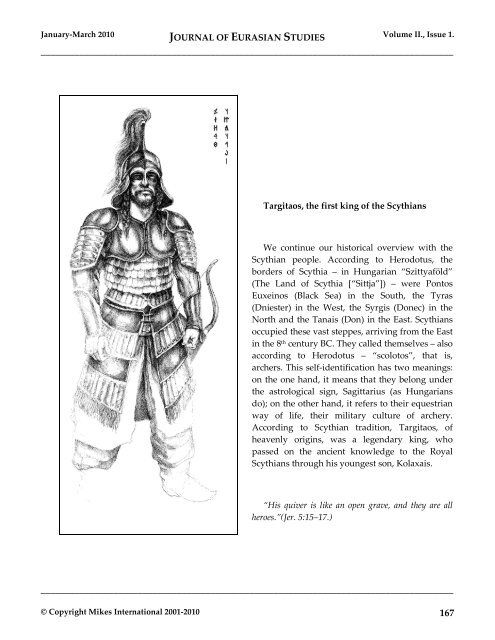EurasianStudies_0110..
EurasianStudies_0110..
EurasianStudies_0110..
You also want an ePaper? Increase the reach of your titles
YUMPU automatically turns print PDFs into web optimized ePapers that Google loves.
January-March 2010 JOURNAL OF EURASIAN STUDIES Volume II., Issue 1.<br />
_____________________________________________________________________________________<br />
Targitaos, the first king of the Scythians<br />
We continue our historical overview with the<br />
Scythian people. According to Herodotus, the<br />
borders of Scythia – in Hungarian “Szittyaföld”<br />
(The Land of Scythia [“Sittja”]) – were Pontos<br />
Euxeinos (Black Sea) in the South, the Tyras<br />
(Dniester) in the West, the Syrgis (Donec) in the<br />
North and the Tanais (Don) in the East. Scythians<br />
occupied these vast steppes, arriving from the East<br />
in the 8 th century BC. They called themselves – also<br />
according to Herodotus – “scolotos”, that is,<br />
archers. This self-identification has two meanings:<br />
on the one hand, it means that they belong under<br />
the astrological sign, Sagittarius (as Hungarians<br />
do); on the other hand, it refers to their equestrian<br />
way of life, their military culture of archery.<br />
According to Scythian tradition, Targitaos, of<br />
heavenly origins, was a legendary king, who<br />
passed on the ancient knowledge to the Royal<br />
Scythians through his youngest son, Kolaxais.<br />
“His quiver is like an open grave, and they are all<br />
heroes.”(Jer. 5:15–17.)<br />
_____________________________________________________________________________________<br />
© Copyright Mikes International 2001-2010 167

















